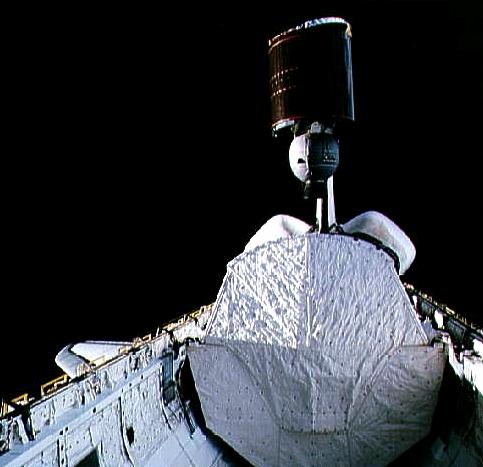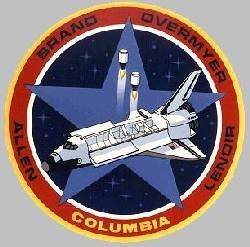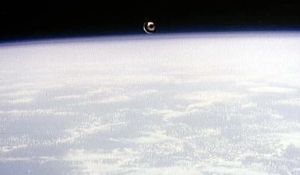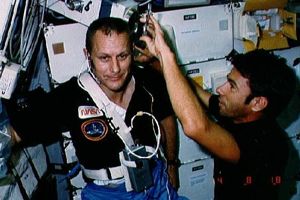
Home - Search - Browse - Alphabetic Index: 0- 1- 2- 3- 4- 5- 6- 7- 8- 9
A- B- C- D- E- F- G- H- I- J- K- L- M- N- O- P- Q- R- S- T- U- V- W- X- Y- Z
STS-5

STS-5
Satellite deployment during STS-5
Credit: NASA
AKA: Columbia. Launched: 1982-11-11. Returned: 1982-11-16. Number crew: 4 . Duration: 5.09 days.
First mission to deploy commercial communications satellites (SBS 3, Anik C3). Payloads: : Satellite Business Systems (SBS)-C with Payload Assist ; (PAM)-D; Telesat-E (Canadian communications satellite) with PAM-D. Monodisperse Latex Reactor (MLR), Continuous Flow Electrophoresis System (CFES), three getaway specials (GAS), Student experiments, GLOW experiment, Vestibular experiment, Oxygen Interaction With Materials experiment.
Orbits of Earth: 81. Distance traveled: 3,397,082 km. Orbiter Liftoff Mass: 112,088 kg. Orbiter Mass at Landing: 91,841 kg. Payload to Orbit: 14,551 kg. Payload Returned: 7,935 kg. Landed at: Concrete runway 22 at Edwards Air Force Base, Cali. Landing Speed: 366 kph. Touchdown miss distance: 498 m. Landing Rollout: 2,911 m.
NASA Official Mission Narrative
Mission Name: STS-5 (5)
COLUMBIA (5)
Pad 39-A (17)
5th Shuttle mission
5th Flight OV-102
Crew:
Vance D. Brand (2), Commander
Robert F. Overmyer (1), Pilot
Joseph P. Allen (1), Mission Specialist
William B. Lenoir (1), Mission Specialist
Milestones:
OPF - July 16, 1982
VAB - Sept 9, 1982
PAD - Sept 21, 1982
Payload:
ANIK-C3,SBS-C
Mission Objectives:
Launch:
November 11, 1982, 7:19:00am EST. Launch proceeded as scheduled with no delays. Launch Weight: 247,113 lbs.
Orbit:
Altitude: 184nm
Inclination: 28.5 degrees
Orbits: 81
Duration: Five days, two hours, 14 minutes 26 seconds.
Distance: 2,110,849 miles
Hardware:
SRB: BI-005
SRM: 005SW(SPM)
ET : 6/SWT-5
MLP: 1
SSME-1: SN-2007
SSME-2: SN-2006
SSME-3: SN-2005
Landing:
November 16, 1982, 6:33:26 a.m. PST, Runway 22. Edwards Air Force Base, Calif. Rollout distance: 9,553 feet. Rollout time 63 seconds. Orbiter returned to KSC Nov. 22, 1982. Landing Weight: 202,480 lbs.
Mission Highlights:
First Shuttle operational mission deployed two commercial com- munications satellites, ANIK C-3 for TELESAT Canada and SitS- C for Satellite Business Systems. Each equipped with Payload Assist Module-D (PAM-D) solid rocket motor, which fired about 45 minutes after deployment, placing each satellite into highly elliptical orbit. One Get Away Special and three Shuttle Student Involvement Program (SSIP) experiments conducted. First scheduled space walk in Shuttle program canceled due to malfunction of space suit.
More at: STS-5.
Family: Manned spaceflight. People: Allen, Brand, Lenoir, Overmyer. Country: USA. Spacecraft: Columbia. Projects: STS. Launch Sites: Cape Canaveral. Agency: NASA, NASA Houston.
 | STS-5 Credit: www.spacefacts.de |
 | STS-5 Satellite deployment during STS-5 Credit: NASA |
 | STS-5 Mission Specialist (MS) Lenoir cuts Pilot Overmyer's hair on middeck Credit: NASA |
 | STS-5 Pilot Overmyer looks over food selections and experiments with beverage Credit: NASA |
 | STS-5 View of OMS burn from the payload bay Credit: NASA |
 | STS-5 STS-5 mission charts Credit: NASA |
1982 November 11 - . 12:19 GMT - . Launch Site: Cape Canaveral. Launch Complex: Cape Canaveral LC39A. Launch Platform: MLP1. LV Family: Shuttle. Launch Vehicle: Space Shuttle.
- STS-5 - .
Call Sign: Columbia. Crew: Allen,
Brand,
Lenoir,
Overmyer.
Payload: Columbia F05 / SBS 3 [PAM-D] / Anik C3 [PAM-D]. Mass: 14,551 kg (32,079 lb). Nation: USA.
Related Persons: Allen,
Brand,
Lenoir,
Overmyer.
Agency: NASA Houston.
Program: STS.
Class: Manned.
Type: Manned spaceplane. Flight: STS-5.
Spacecraft Bus: Shuttle.
Spacecraft: Columbia.
Duration: 5.09 days. Decay Date: 1982-11-16 . USAF Sat Cat: 13650 . COSPAR: 1982-110A. Apogee: 317 km (196 mi). Perigee: 294 km (182 mi). Inclination: 28.50 deg. Period: 90.50 min.
Manned four crew. First mission to deploy commercial communications satellites (SBS 3, Anik C3). Payloads: : Satellite Business Systems (SBS)-C with Payload Assist ; (PAM)-D; Telesat-E (Canadian communications satellite) with PAM-D. Monodisperse Latex Reactor (MLR), Continuous Flow Electrophoresis System (CFES), three getaway specials (GAS), Student experiments, GLOW experiment, Vestibular experiment, Oxygen Interaction With Materials experiment.
1982 November 12 - .
- STS-5 - Wakeup Song: 76 Trombones - . Flight: STS-5. "76 Trombones" from the"Music Man".
1982 November 13 - .
- STS-5 - Wakeup Song: Cottoneye Joe - . Flight: STS-5. "Cottoneye Joe".
1982 November 14 - .
- STS-5 - Wakeup Song: Halls of Montezuma - . Flight: STS-5. "Halls of Montezuma" Marine's Hymn in honor of two Marines onboard: Columbia pilot Bob Overmyer, active duty Marine Corps colonel, and Vance Brand who began his career as a Marine aviator.
1982 November 15 - .
- STS-5 - Wakeup Song: The Stroll - . Flight: STS-5. "The Stroll".
1982 November 16 - .
- STS-5 - Wakeup Song: Take Me Home, Country Roads - . Flight: STS-5. "Take Me Home, Country Roads" by John Denver.
1982 November 16 - .
- Landing of STS-5 - . Return Crew: Allen, Brand, Lenoir, Overmyer. Nation: USA. Related Persons: Allen, Brand, Lenoir, Overmyer. Program: STS. Flight: STS-5. STS-5 landed at 14:33 GMT. .
Back to top of page
Home - Search - Browse - Alphabetic Index: 0- 1- 2- 3- 4- 5- 6- 7- 8- 9
A- B- C- D- E- F- G- H- I- J- K- L- M- N- O- P- Q- R- S- T- U- V- W- X- Y- Z
© 1997-2019 Mark Wade - Contact
© / Conditions for Use